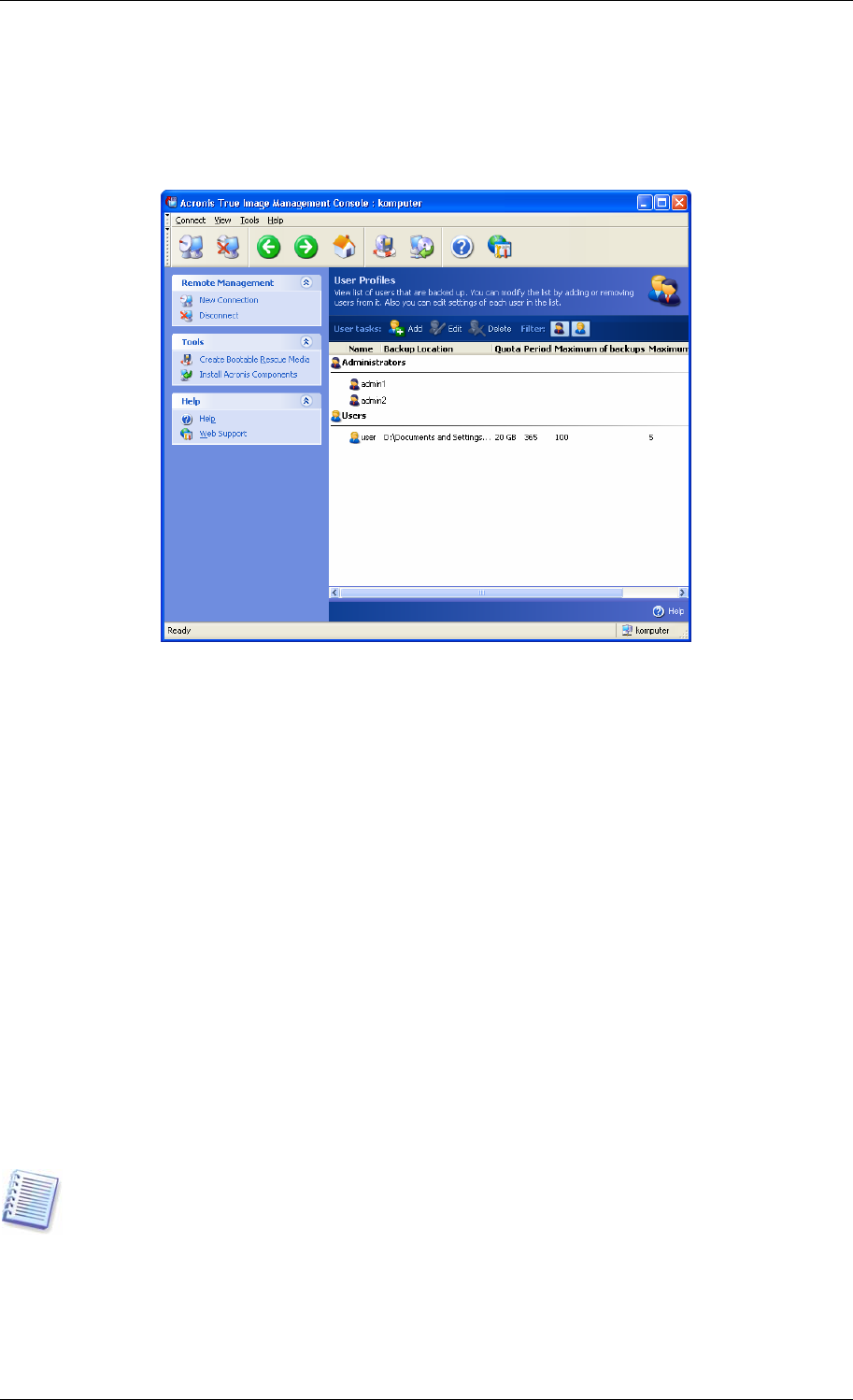User Guide
Table Of Contents
- Chapter 1. Introduction
- Chapter 2. Acronis True Image Enterprise Server installatio
- Chapter 3. General information and proprietary Acronis tech
- 3.1 The difference between file archives and disk/partition
- 3.2 Full, incremental and differential backups
- 3.3 Acronis Secure Zone
- 3.4 Acronis Startup Recovery Manager
- 3.5 Acronis Backup Server
- 3.6 Acronis Snap Restore
- 3.7 Acronis Universal Restore
- 3.8 Using dynamic disks and volumes
- 3.9 Backing up to tape drive
- 3.10 Viewing disk and partition information
- Chapter 4. Using Acronis True Image Management Console
- Chapter 5. Using Acronis True Image Enterprise Server (loca
- Chapter 6. Creating backup archives
- Chapter 7. Restoring the backup data
- 7.1 Restore under Windows or boot from CD?
- 7.2 Restoring files and folders from file archives
- 7.3 Restoring disks/partitions or files from images
- 7.3.1 Starting the Restore Data Wizard
- 7.3.2 Archive selection
- 7.3.3 Restoration type selection
- 7.3.4 Selecting a disk/partition to restore
- 7.3.5 Selecting a target disk/partition
- 7.3.6 Changing the restored partition type
- 7.3.7 Changing the restored partition file system
- 7.3.8 Changing the restored partition size and location
- 7.3.9 Assigning a letter to the restored partition
- 7.3.10 Restoring several disks or partitions at once
- 7.3.11 Using Acronis Universal Restore
- 7.3.12 Setting restore options
- 7.3.13 Restoration summary and executing restoration
- 7.4 Setting restore options
- Chapter 8. Scheduling tasks
- Chapter 9. Managing Acronis Secure Zone
- Chapter 10. Creating bootable media
- Chapter 11. Other operations
- Chapter 12. Mounting an image as a virtual drive
- Chapter 13. Transferring the system to a new disk
- 13.1 General information
- 13.2 Security
- 13.3 Executing transfers
- 13.3.1 Selecting Clone mode
- 13.3.2 Selecting source disk
- 13.3.3 Selecting destination disk
- 13.3.4 Partitioned destination disk
- 13.3.5 Old and new disk partition layout
- 13.3.6 Old disk data
- 13.3.7 Destroying the old disk data
- 13.3.8 Selecting partition transfer method
- 13.3.9 Partitioning the old disk
- 13.3.10 Old and new disk partition layouts
- 13.3.11 Cloning summary
- 13.4 Cloning with manual partitioning
- Chapter 14. Adding a new hard disk
- Chapter 15. Command-line mode and scripting

To do so, first, add this person to AcronisBackupServerUsers group. Then click Set up User
profiles -> Add, select the user name and specify backup location, quotas and time limits
for this user in Add User Profile Wizard windows. Use the default backup location, quotas
and time limits or make particular settings for the new user. If you specify a new path to
backup location for the new user, a new backup location will be created.
To add another administrator, first add this person to AcronisBackupServerUsers group. Then
click Set up User profiles -> Add, select the user name and choose Create user with
administrator’s rights on the next page.
An administrator can manage all archives on the backup server regardless of their owner,
while a common user can only backup or restore his data from the backup server. An
administrator has no user profile, in other words, he is not assigned a backup location,
quotas and time limits like common users are. He uses administrator profile for both
remotely and locally controlled backups.
4.5.4 Changing User profiles
You might need to change a user profile already set. To do so, select the user and click Edit.
The Edit User Profile Wizard will guide you through the same selections, as the Add User
Profile Wizard, except administrator’s or user’s rights. To change the rights, you will have
to delete the user profile and then add the user again with the new rights.
Changing the user’s backup location will move all existing and redirect future backups,
performed by the user, to another folder (device, etc). As moving files may take a lot of time
and system resources, it is recommended that you schedule this operation for the time when
the backup server computing load will be minimal. You can do it in the Start Parameters
window. To complete configuring the profile, click Finish in the final summary window.
To change user’s backup location within the same device, you must have at least as much
free space on the device as the user’s archives occupy, because the archives will first be
copied to the new location, and then deleted from the old place.
If you select a user and click Clear, all archives created by this user will be deleted. The
same operation for administrator profiles is not possible.
Copyright © Acronis, Inc., 2000-2006 39










